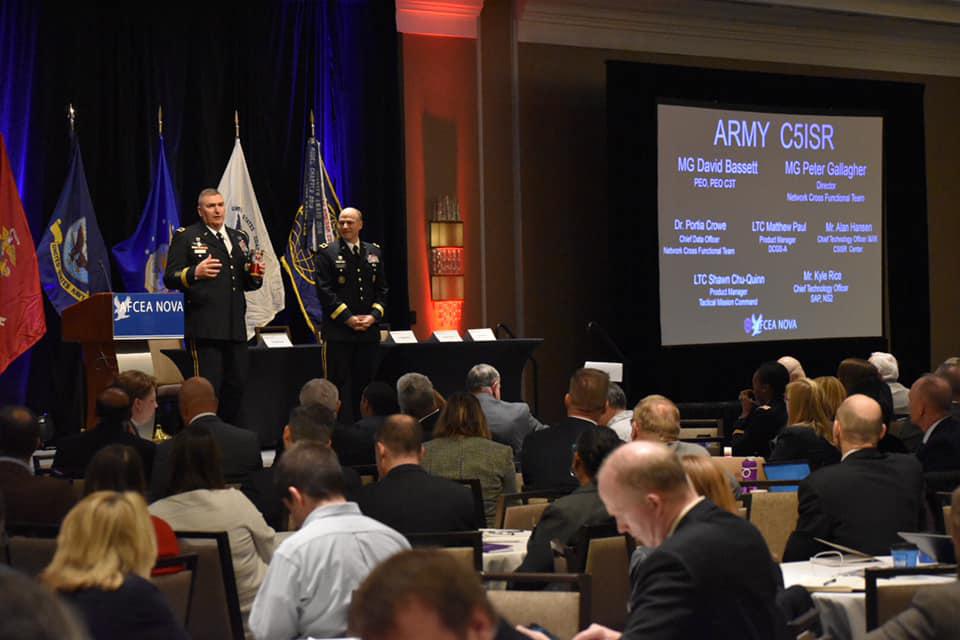The Army's Pursuit of a Revolutionary Network Environment
The U.S. Army’s work on advancing its tactical network through its “capability package construct” will pull in significant capacity, added resiliency and interoperability, leaders say. The Army is leveraging more commercial solutions than ever, as well as its own Science and Technology Directorate research and development, to bring a competitive edge.
As part of its latest pursuit of solutions for the Integrated Tactical Network concept, or ITN, the Army is going after high capacity commercial satellite communications, protected waveforms, mid-earth-orbit constellations, and space-based Internet.
The service will add hardened radio, obfuscation of radio frequency and electromagnetic spectrum capabilities. The Army’s efforts, to be fielded in fiscal year 2023 as part of the so-called Capability Set (CS) 23, will increase bandwidth and mobility for improved maneuvering and communications in tactical environments, according to Maj. Gen. David Bassett, USA, program executive officer for Command, Control, Communications-Tactical (PEO C3T) and Maj. Gen. Peter Gallagher, USA, director of the Network Cross-Functional Team (CFT), who are overseeing the network modernization effort.
The Army also seeks to integrate assured position, navigation and timing solutions for mounted and dismounted applications; low-profile antennas; artificial intelligence and machine learning; data management; cloud solutions that support training and improved readiness; and streamlined software, hardware and data for kill chain and decision making, the leaders indicate. The unified network must also support operations across all domains and offer Joint interoperability and coalition use, including managing both trusted and untrusted user access.
For the last two years, the Network CFT and the PEO C3T, as well as leaders from the Program Executive Office for Intelligence, Electronic Warfare and Sensors and from the Army Futures Command, have embarked on fulfilling the Army’s network modernization plan through these two-year iterative capability additions. The Army will field CS 23 to Stryker and armor brigades, building on the first network package delivered to infantry teams in 2021 during CS 21. CS 21 includes: communication capabilities that are smaller, lighter and faster; easy-to-use applications and devices; and multiple options for connectivity with improved network security and management systems, according to PEO C3T. Some of those industry solutions are capabilities previously used by Special Operations forces only, the leaders share.
“We’ve gone from a legacy acquisition and technology development process … to now really much more of a technology-driven, soldier-informed process that is designed to allow us to capitalize on available technologies,” Gen. Bassett explains. “The process is giving industry the opportunity to really show us what that available technology is and then, through a very deliberate set of repetitive opportunities with soldiers, informed by leaders, we’ve got the opportunity to bring that technology in and show how it integrates.”
In November, the leaders held a technical exchange meeting (TEM) in Austin, Texas, with 672 industry participants, discussing critical network design components and related integration requirements for CS 23. Feedback from the TEM led to a call in January for industry white papers based on six technology topics. This March, Army developers and integrators are conducting a pitch competition and demonstration with select industry vendors to determine capability readiness for prototype procurement and experimentation. Through an other transactional agreement process, successful vendors will compete for prototype contract awards to support Network CFT experimentation to inform CS 23 preliminary designs. The leaders also will perform the critical design review for CS 21, which will lead to a fielding decision for CS 21 systems.
“It is a significant milestone of where we’re at in terms of evaluation of the network, from the preliminary design review feedback we are getting from the 82nd Airborne Division for Capability Set 21,” Gen. Gallagher notes. “We went through the preliminary design review last month for CS 21, which included not only the ITN for our maneuver formations but also capabilities for some of those echelons above brigade that will be provided by our Expeditionary Signal Battalions. At the TEM in Austin for CS 23, it was a good mix of some of the usual suspects in terms of industry that have worked very closely with the government, and then we had a lot of nontraditional industry folks and a small subset of start-ups that were there. I think what makes it exciting this time is that they know this is the first fiscal year that we’ve actually aligned resources for prototyping, and so I think industry is excited.”
For satellite communications, or SATCOM, the leaders are working to expand the capacity and decrease latency of their network transport by leveraging commercial “mega” satellite constellations, especially in mid earth orbit (MEO), as well as related advanced antenna capabilities.
“What we’re looking at right now is multipath connectivity in our network transport and in our backbone,” explains Gen. Gallagher. “Right now, the majority of our network transport relies very heavily on military SATCOM and some commercial SATCOM that are operating at geosynchronous orbit. There’s a limited amount of bandwidth or capacity and there’s also some latency. We’re looking to go with emerging technologies, capitalizing on some of the industry solutions that are already out there in terms of MEO satellite constellations that provide higher capacity and lower latency, which gives us basically more bandwidth and more throughput for our network.
With the help of the C5ISR Center at Aberdeen, the Network CFT and PEO C3T have already started prototyping with some MEO solutions for CS 23, including antenna work, as MEO-based SATCOM does require slightly different transmitter and receiver solutions. “The actual dish itself may not necessarily be completely different, but some of the components inside that dish [will be], because they’re operating at a different altitude and they’re operating on different spectrum,” Gen. Gallagher notes.
They are starting with experimentation to get the right components for antennas in stationary environments, then will progress over the next few months to on-the-move antenna capabilities for MEO applications. “What we’re looking at for antennas is trying to find basically a streamlined antenna, that has a fairly low signature, as much as possible,” he says. “We want to have obviously high gain and the ability to have high power so we can operate on the move or at the halt and be able to provide higher capacity and resilient networks.”
Internet supported by satellite constellations, which companies such as OneWeb and SpaceX are developing, also is of interest to the Army for use in tactical environments. “Space-based Internet through those constellations is also emerging and should be available by the time we’re ready to fill capabilities for CS 23,” Gallagher continues. “We are watching them very closely, although they are not ready yet for prototyping.”
As for cloud, the Network CFT and PEO C3T are sorting out how to have a cloud-enabled tactical platform but not be cloud-dependent. “We have to really define for the Army what cloud means for the tactical environment,” Gen. Bassett explains. “On the commercial side, we all understand cloud services, and we all understand the limitation that when we lose connectivity to that cloud server, the functionality associated with that service goes away. When we try to apply it to the tactical space, we think that the technologies associated with cloud hosting and data replication are all tremendously powerful and we want to leverage them, but we acknowledge that we have to have capabilities that will continue to operate with or without a connection to a centralized cloud server.”
The Network CFT and PEO C3T started some initial pilot work to explore how cloud could actually benefit from a tactical approach, Gen. Gallagher says. “One of the first efforts we’ve got is where we’re looking at putting our Mission Command systems in the cloud environment to enable Army Reserve and National Guard organizations that may not have the ability to operate their tactical server infrastructure on a regular basis and still have access to those kind of systems and be able to stay trained and ready,” he says.
In addition, the Network CFT and PEO C3T are examining how to leverage the cloud at the echelon level. “We are looking for several initiatives where over time we may take what we’re doing in virtualization today in some of our tactical server infrastructure and evolve it to containerization, or as things become cloud ready, we can extend what might be operating in the cloud and create basically a cloud but in a tactical environment,” Gen. Gallagher states. “While we want to ensure that we can be cloud-enabled in the tactical space, we also want to have edge computing and the processing power necessary for when the cloud link gets severed or we lose connectivity, so we don’t lose access to the data.”
Moreover, the leaders fully expect adversaries to have electronic warfare (EW) capabilities to disrupt communications, and so the Army’s future EW solutions would not only address jamming but also would still operate in a hostile environment.
“We have several options to address jamming,” Gen. Gallagher shares. “We are looking to upgrade our satellite modems to make them more anti-jam capable and we are leveraging advanced waveforms in our Radio Net, with the next generation SINCGARS [single channel ground and airborne radio system] waveform.”
“As we look to leverage available commercial technology, not everything that we buy is going to be able to communicate in the face of hostile warfare or in a jamming environment, but we do want to make sure that we have a set of capabilities so that as one capability is denied, we have other capabilities, probably that provide less throughput but can continue to operate through that environment, so that we have multiple means of communication,” Gen. Bassett adds, speaking to the intended resiliency and redundancy of network communications. “Where we don’t have jamming, we want to be able to get a lot of throughput and where we do have jamming, we want to give commanders options to switch over to alternative communications means, so that the message gets through.
“As we approach 2023, we’re looking to industry to help prescribe waveforms, in addition to the ones that we’re developing within the Army, that have the ability to operate under the noise floor where they are much more difficult to detect and jam as well,” Gen. Bassett states.
By bringing in capabilities every two years, the Army is creating room for technological advancements, Gen. Bassett stresses. The service had to change the old legacy way of procurement for the tactical network, or it would be faced with outdated solutions not relevant to warfighters’ needs.
“In the past, we might have wanted to project into the future and kind of pick which technologies we thought would be successful at a given time, and we’d write requirements for that and maybe we would be on the front end trying to do that development for industry,” Gen. Bassett explains. “Instead, we’re saying that we know industry is developing these capabilities, we’re not sure which of them are going to be viable yet for us to take advantage of, but we want to have a process in place that lets us experiment with it and then pick the ones that perform the best that are actually available and mature.”






Comments